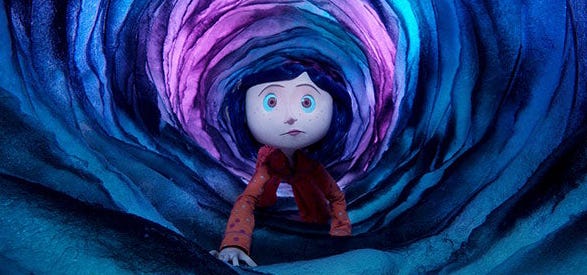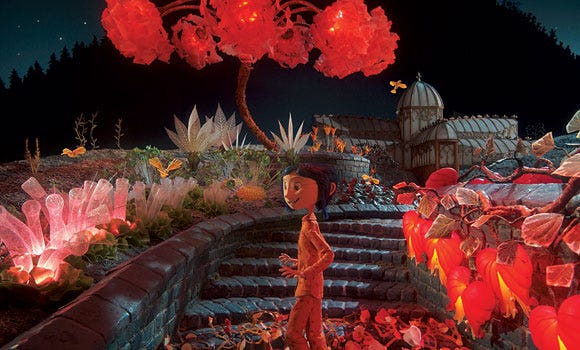Masterpiece of Film: CORALINE
What seems like a beautiful dream can turn into a nightmare if our hearts are in the wrong place.
Henry Selick and Neil Gaiman’s CORALINE is one of my favorite things in this world. The animation, the music, the story, the design, the screenplay, the 3D effects, the suspense, the horror, the delight, the characters, the voices, the imagination…it still holds up as a timeless classic and masterpiece of animated storytelling.
After a recent re-watch, I dug up some old reflections I wrote when it was released in 2009 (from a defunct website so I had to use the Internet Archive’s Wayback Machine to find it).
It’s Not About “Me”
It’s one of the hardest lessons to learn in life, when we realize that happiness doesn’t come from a life centered around ourselves. There is the great American dream of the highest pinnacle in life being one of celebrity, where you are adored, worshiped, catered to at every turn, and can eat, buy, or do pretty much anything you want, whenever you want. We see it manifested completely in competitive reality shows where ordinary people with seemingly crummy lives think their salvation lies in going after their “one shot” to have their name flashing in lights and all of their “dreams come true.” But what seems like a beautiful dream can often turn into a nightmare if our hearts are in the wrong place.
What’s in a Name?
This temptation seems all too sweet for young Coraline. She is headstrong, creative, and independent, but also sees her life as incredibly boring. The boredom comes from her self-imposed belief that everyone in her world is somehow lower than she is. Her new neighbors are freaks, her parents are boring and pre-occupied, and Oregon is certainly not as interesting as her home town of Michigan. She feels she is above all of this, and because of that, it annoys her to no end when people constantly mis-pronounce her name (as “Caroline”, not Coraline). It annoys her because her life is all about her and she focuses on the things that don’t meet her approval.
Coraline’s parents, though they may be jaded and focused on their own lives as well, suggest that Coraline find a channel for her creativity by exploring their new house, which leads to the discovery of the other world behind the door. In this alternate world, it’s interesting to note the constant repetition of Coraline’s name. Nobody mis-pronounces it, and she squeals in delight when seeing it spelled out by performing mice in her own personal circus performance. Her face, too, is lovingly re-created as a beautiful garden when seen from above.
It is indeed delightful to be named and adored… it is part of what gives us our identity. Our parents name us at birth, and I love the image in Revelation 2:17 which suggests we will each receive a white stone revealing our new name in the image of a transcendent Creator that personifies the love of both father and mother.
So what happens if our “other mother” appears to love us more, and who exactly is this “other mother?” She is someone who "cannot create, but only copy, twist and change things from the real world when constructing her version of it.” But a life with ourselves at the center is a twisted web, because it doesn't fit why we were created.
It’s About Others and Living in Community
After seeing the “other mother” for who she really is, Coraline risks her life to save the others who have been caught in her deadly trap. She also realizes the importance of finding happiness in the community of her new neighborhood. Rather than close herself off and think of herself as being more important than others, she instead reaches out to others, inviting her neighbors (including Wybie’s grandmother) to share community together.
It is in this selfless giving of ourselves that we reflect the image of who created us in the first place.








